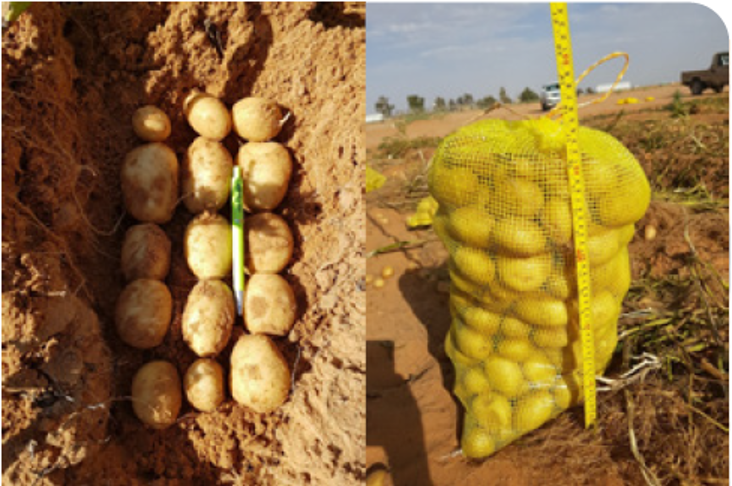Potato yield increased with 14%, at profit of 985 USD/ha following a potassium nitrate based nutrient programme in Saudi Arabia
Felipe Garziera (Market Development Manager, SQM International N.V.) recommended to use a differentiated fertilization programme based on potassium nitrate, with Qrop® Complex Top K (12-6-24 with S, Ca and Mg) and Ultrasol® K (Potassium NItrate), as replacement of urea, potassium sulphate and high P-NPK formula in local farmers practice.
SQM’s product line enables application of potassium nitrate as prilled Qrop® and water soluble Ultrasol®, designed to fit in a well-balanced fertilizer programme. This improved total K supply to the crop, the N:K balance and increased percentage of nitric nitrogen of total applied nitrogen.
In a trial carried out by ASDCO in Saudi Arabia on potato under pivot irrigation, the optimized nutrition programme resulted in 14% extra yield and revenue, amply compensating higher costs of SQM programme and satisfying the farmer with a net extra profit of 985 USD/ha (Table 1).
Use of Ultrasol® Magnum P44 was recommended as the main source of phosphorus for this crop grown on highly alkaline soils to lower the pH of the nutrient solution. Following SQM’s recommendation, based on crop requirement, total phosphorus application was confidently reduced to 197 kg P2O5/ha (from 275 kg P2O5/ha in the farmers practice).

Figure 1. Ibrahim Al-Salamah (Farmer son), Levi Bin (Nouryon), Felipe Garziera (SQM), Majed Samawi (SQM), Ali Al-Salamah (Farmer), Mohammad Al-Kawamleh (ASDCO) and Wassef T. Ali (ASDCO).
A good understanding of crop requirements, fertilizer application and placement, local soil and climate conditions, and farmers fertilizer practice is essential to design a customized nutrition programme. Visits of the trial locations to meet the grower and local agronomists are important, to learn about all the local limitations for achieving maximal profit from a crop. Close collaboration is key for success of the trial coordinated with Majed Samawi (SQM’s sales manager for the Middle East) and performed by agronomists of the distributor ASDCO (Agro Supply & Development Company) - Eng. Mohammad AL-Kawamleh (technical manager) and Eng. Wasssef Taha (Hail branch manager) - and the grower Mr. Ali Al-Salamah.
Following a visit of Saudi Arabia with Majed Samawi to provide training on the benefits of potassium nitrate organized by ASDCO, Felipe Garziera designed a nutritional programme to improve yield of potato grown under pivot irrigation in the northern region of Saudi Arabia (Hail) by Mr. Ali Al-Salamah.
Main challenges in the region are alkaline soils (pH 7,6), and a desert climate with extremely high temperatures and drought. The sandy soil in the area is suitable for growing potato and sufficient irrigation water is available. The trial was performed to confirm the theory about benefits of a balanced plant nutrition programme based on KNO3 instead of SOP and urea.
Both soil applied and water soluble fertilizers were applied on half pivot fields of 11 ha. Two treatments were compared: regular farmer’s programme, and a programme based on Qrop® Complex Top K, Ultrasol® K and UItrasol® Magnum P44 (Table 2). Granular fertilizers were soil applied, the water- soluble sources were applied with pivot irrigation. Yield of tubers was assessed collecting the average yield from the total surface of 11 ha.
Table 1. Yield results and financial analyses of the benefit of the SQM programme based on potassium nitrate, over the farmers practice (FP). Price of produce was 1000 SAR=267 USD/MT, 3,75 SAR=1 USD.

Table 2. Fertilizer programme details of the SQM recommendations and the farmers practice (FP). Total fertilizer dose was divided over split applications every week. Micro-nutrients, amino-acids and humic acids were applied occasionally at the same rates in both programmes.


Figure 2A. Farmers practice, 25 and 60 days after planting.

Figure 2B. SQM programme, 25 and 60 days after planting.

Figure 3A. Farmers practice 45 days after planting.

Figure 3B. SQM programme 45 days after planting.

Figure 4. Collection of soil sample for analysis.
The optimal N:K balance, increase of total K-fertilizer, reduction of total P-fertilizer and improvement of the percentage NO3 in total N ratio, increased tuber yield by 6 MT/ha, a 14% increase over the farmers practice yield of 46 MT (Table 1).
Despite higher costs for the SQM programme, this yield increase was more than double the break-even point (2,5 MT/ha extra tuber yield), resulting in a considerable extra net profit of 985 USD/ha.

Figure 5A. Farmers practice, pre-harvest assessment at 80 days and harvest at 100 days after planting.

Figure 5B. SQM programme, pre-harvest assessment 80 days after planting and harvest at 105 days after planting.
The grower was impressed by the results and is shifting part of his use of SOP and urea to Qrop® Complex Top K and Ultrasol K, and he will use these in his personal programme, for a second season’s evaluation, in addition to his use of Magnum® P44.
A poster has been prepared with this work to be presented in Riyadh Agri expo in Saudi Arabia and a leaflet about the programme was distributed for visitors.


